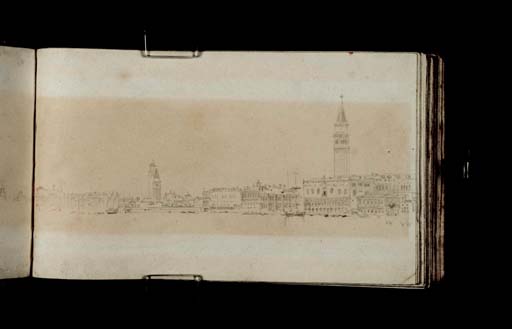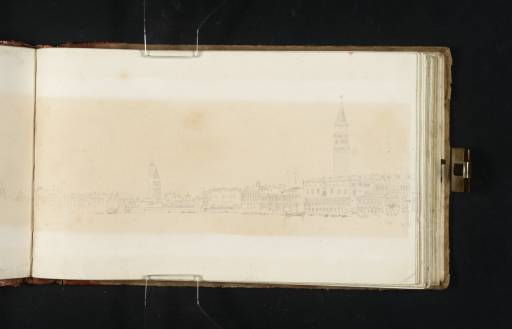Joseph Mallord William Turner Part of a Panoramic View from the Bacino, Venice: The Entrance to the Grand Canal, Campanili of San Stefano, San Moisè and San Marco (St Mark's) and the Palazzo Ducale (Doge's Palace) 1819
Image 1 of 2
-
 Joseph Mallord William Turner, Part of a Panoramic View from the Bacino, Venice: The Entrance to the Grand Canal, Campanili of San Stefano, San Moisè and San Marco (St Mark's) and the Palazzo Ducale (Doge's Palace) 1819
Joseph Mallord William Turner, Part of a Panoramic View from the Bacino, Venice: The Entrance to the Grand Canal, Campanili of San Stefano, San Moisè and San Marco (St Mark's) and the Palazzo Ducale (Doge's Palace) 1819 -
 Joseph Mallord William Turner, Part of a Panoramic View from the Bacino, Venice: The Entrance to the Grand Canal, Campanili of San Stefano, San Moisè and San Marco (St Mark's) and the Palazzo Ducale (Doge's Palace) 1819 (Enhanced image)Enhanced image
Joseph Mallord William Turner, Part of a Panoramic View from the Bacino, Venice: The Entrance to the Grand Canal, Campanili of San Stefano, San Moisè and San Marco (St Mark's) and the Palazzo Ducale (Doge's Palace) 1819 (Enhanced image)Enhanced image
Joseph Mallord William Turner,
Part of a Panoramic View from the Bacino, Venice: The Entrance to the Grand Canal, Campanili of San Stefano, San Moisè and San Marco (St Mark's) and the Palazzo Ducale (Doge's Palace)
1819
Joseph Mallord William Turner 1775–1851
Folio 60 Verso:
Part of a Panoramic View from the Bacino, Venice: The Entrance to the Grand Canal, Campanili of San Stefano, San Moisè and San Marco (St Mark’s) and the Palazzo Ducale (Doge’s Palace) 1819
D14430
Turner Bequest CLXXV 60a
Turner Bequest CLXXV 60a
Pencil on white wove paper, 112 x 185 mm
Inscribed by Turner in pencil ‘VW VW’ centre right, below buildings
Inscribed by Turner in pencil ‘VW VW’ centre right, below buildings
Accepted by the nation as part of the Turner Bequest 1856
Exhibition history
1904
National Gallery, London, various dates to at least 1904 (602h, as ‘The Doge’s Palace and Mint’, one of ‘Twelve Leaves from a Book of Sketches at Venice’).
References
1904
E.T. Cook and Alexander Wedderburn eds., Library Edition: The Works of John Ruskin: Volume XIII: Turner: The Harbours of England; Catalogues and Notes, London 1904, pp.304 no.260, as ‘The Doge’s Palace and Mint’, 636 no.602, as one of ‘Twelve Leaves from a Book of Sketches at Venice’.
1909
A.J. Finberg, A Complete Inventory of the Drawings of the Turner Bequest, London 1909, vol.I, p.514, CLXXV 60 [sic], as ‘The Doge’s Palace and Mint. Exhibited drawings, No.602h, N.G.’.
1930
A.J. Finberg, In Venice with Turner, London 1930, p.165, as ‘p. 60. The Ducal palace to the mouth of the Grand Canal’.
1974
Gerald Wilkinson, The Sketches of Turner, R.A. 1802–20: Genius of the Romantic, London 1974, reproduced p.185, noting ‘The Doge’s Palace’.
2003
Ian Warrell in Warrell, David Laven, Jan Morris and others, Turner and Venice, exhibition catalogue, Tate Britain, London 2003, pp.83, 263 note 2.
The drawing is inverted relative to the sketchbook’s foliation. Folios 59 recto and verso, 60 verso and 61 recto (D14427–D14428, D14430–D14431) form a continuous panoramic west view across the Bacino, from the Isola di San Giorgio Maggiore to the south to the Riva San Biagio to the north; Turner would have had to temporarily turn back D14430 and D14428 to match their outer edges to the points were the overall view continued.1
Finberg subsequently annotated his 1909 Inventory entry for this page (‘The Doge’s Palace and Mint’): ‘St Moses. Zecca. Campl.’2 The Turner scholar C.F. Bell marked another copy: ‘Panorama from middle of Bacino Prison to r Pal. Corner to l’.3 At the gutter is the Palazzo (or Ca’) Corner della Ca’ Grande (or Granda), on the Grand Canal. Aligned towards the centre are the campanili of San Stefano and the nearer San Moisè. Towards the right the campanile of St Mark’s rises west of the Palazzo Ducale (Doge’s Palace) and New Prison.
When this leaf was rebound and stamped after being displayed in the nineteenth century, Finberg’s 1909 Inventory sequence, clear from his descriptive titles for the recto and verso, was disrupted. What is now the recto (D14429) was, by the implication of an ‘a’ suffix in his Inventory, the verso in his estimation, but it has since been bound as the recto and stamped as ‘60’. The present page was evidently, by its subject matter and more light-affected condition, the exhibited side.
For other drawings made in the vicinity and an overview of Turner’s coverage of Venice, see the sketchbook’s Introduction.
Technical notes:
Finberg subsequently annotated his 1909 Inventory entry: ‘? Rep[?d] ([...]) | yes | 13/8/29’,1 apparently concerning conservation work after the 1829 Tate Gallery flood.
Matthew Imms
March 2017
How to cite
Matthew Imms, ‘Part of a Panoramic View from the Bacino, Venice: The Entrance to the Grand Canal, Campanili of San Stefano, San Moisè and San Marco (St Mark’s) and the Palazzo Ducale (Doge’s Palace) 1819 by Joseph Mallord William Turner’, catalogue entry, March 2017, in David Blayney Brown (ed.), J.M.W. Turner: Sketchbooks, Drawings and Watercolours, Tate Research Publication, July 2017, https://www

